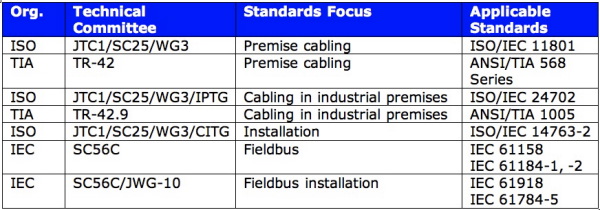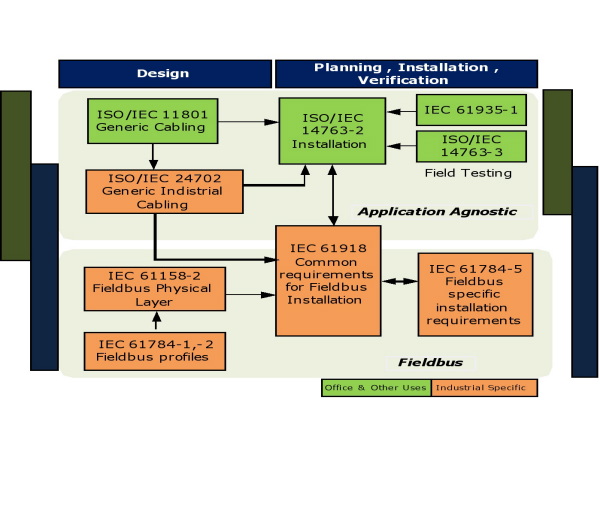
News
Understanding Industrial Ethernet standards by Ron Groulx Feb09
February 27, 2009 | By Anthony Capkun
Understanding Industrial Ethernet standards
By Ron Groulx
When working in the design and installation of an industrial network, technicians often find themselves facing a bewildering array of standards written by numerous international, regional, national and trade organizations. The foundation for ensuring successful plan, installation and maintenance of an Ethernet network is an understanding of the key standards in use today and their applications.
Ethernet
standards used in industrial environments are more complex and
stringent than those in office environments. That is because the
mission-critical control-based applications traffic carried on an
industrial network demands extremely high reliability with
deterministic timing. In production environments there is far less
tolerance for any excess latency that can lead to slowdowns or even
breakdowns. Besides the standard throughput and performance issues,
there are specific standards also address the extra stresses of harsh
environments such as vibration, electrical noise, equipment in motion,
impact dangers, and all manner of contaminants. Finally, standards play
an important role in ensuring application backward-compatibility with
legacy systems—a key factor in any industrial implementation.
Cutting through the confusion
 Given
Given
the myriad of factors to consider, getting a handle on industrial
Ethernet standards can be extremely confusing and challenging. For
example, the standards that apply to designing cabling components or
networks for commercial and industrial Ethernet include ISO/IEC 11801,
the ANSI/TIA 568 series, ISO/IEC 24702, IEC 61158-1, – 2, IEC 61784-1,
-2, and ANSI/TIA 1005 apply. When planning and installation of the
physical infrastructure for industrial Ethernet automation networks,
technicians need to apply ISO/IEC 14763-2, IEC 61918, and 61784-5
standards to ensure robustness, compatibly, and maintainability.
While
this all seems overwhelming, proper education and training can help
sort through the confusion. A good place to start is gaining an
understanding of the various technical committees, their areas of focus
and their standards. Table 1 provides a basic outline of those
committees and their areas of focus.
In
addition to ISO, IEC and TIA, there are other regional cabling
standards groups—including CSA (Canadian Standards
Association)—that develop specifications for their geographic area or
country. These regional standards are usually in harmony with ISO, IEC,
and TIA requirements.
{mospagebreak}
The standards explained
Figure 1
outlines the specific standards that a technician should know when
working with industrial Ethernet. It maps out the key ISO, IEC and
joint ISO/IEC standards required in the design, and then in the
planning, installation, verification, and testing of industrial
Ethernet.
Looking at the “application agnostic” portion of the chart, following is a brief explanation of the standards:
•
ISO/IEC 11801 is the base standard covering generic structured cabling.
It covers cabling systems that are typically used for premise local
area networks and specifies end-to-end physical media and transmission
performance.
 •
•
ISO/IEC 14763-2 specifies planning, installation, and operation of
infrastructures in support of generic cabling, including implementation
of cabling, pathways, spaces, grounding and bonding. It covers work
specifications, quality assurance, installation planning and practice,
documentation and administration, testing, inspection, operation and
repair and maintenance.
• IEC
61935-1 and ASO/IEC 17463-3 specifications cover field testing based on
the ISO/IEC 11801 standard for copper and fiber respectively.
•
ISO/IEC 24702 builds upon the office premise generic cabling standard
ISO/IEC 11801, and modifies the requirements for industrial premises,
taking into account MICE (mechanical, Ingress, climatic and
electromagnetic) classifications.
{mospagebreak}
The “Fieldbus” portion of the chart addresses the following standards:
• IEC
61158-2 specifies ‘Fieldbus for use in industrial control systems –
Part 2: Physical Layer specification” that covers non-Ethernet Fieldbus
cabling. This document should be used in conjunction with the Fieldbus
profiles documents IEC 61784-1 and IEC 61784-2 to specify the cabling
requirements for individual non-Ethernet Fieldbus implementation.
• IEC
61918 standardizes common elements across all the Fieldbuses, and IEC
61784-5 provides profile-specific installations requirements. Use these
two documents as a set to specify installation requirements.
Specification
documents for these products are large and can be rather expensive. The
IEC does however package and sell groups of IEC 61158, IEC 61918, and
61784 documents pertinent to the Fieldbus being used.
How the TIA specifications fit in
One other factor to consider is the TIA generic cabling standard series.
ANSI/TIA-568
is fairly well aligned with the ISO/IEC generic cabling standard 11801
with some terminology differences. A few examples are:
• An ISO equivalent of a TIA category 5e installed cable system is ISO Class D.
• An ISO equivalent to a TIA category 6 installed cable system is Class E.
•
ISO/IEC 11801 references a separate IEC specification that covers
component performance such as individual connectors. These IEC
component specifications use the same category 5e/6/6A performance
classifications as TIA.
•
TIA-1005 “Telecommunications Infrastructure Standards for Industrial
Premises” is the TIA equivalent of ISO/IEC 24702. This standard adds
topology, environmental and electrical transmission requirements for
industrial premises.
Getting help
Anyone
unfamiliar with these standards can contact the appropriate trade
organizations for additional information. Fieldbus developers for
example offer an excellent source of standards-compliant application
guides for their products. Additional information and support can also
be found through organizations such as BICSI, IEAG and ISA.
This is
only a basic sampling of what technicians need to know when working
with industrial Ethernet standards. Getting the proper education and
training are integral to ensuring the success of any Ethernet design,
installation and maintenance process. While it does take time, effort
and training, getting to know the ropes is definitely worth the
investment over the long term.
Ron
Groulx is product manager for FLUKE NETWORKS CANADA. Having worked in
the industry for almost ten years and a graduate in computer science,
he is knowledgeable in all aspects of networking from cabling
infrastructure to network monitoring and troubleshooting. E-mail
ron.groulx@fluke.com to contact the author.
Print this page